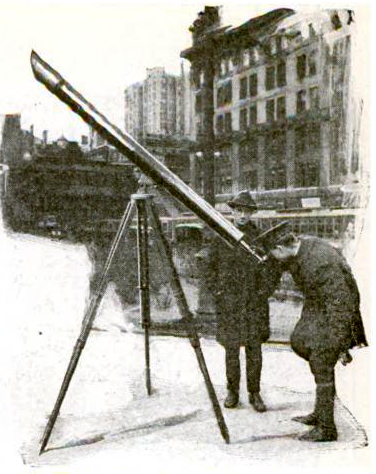A Brief History of Sidewalk Astronomy

With the Central Park Urban Starfest coming on September 22, now is an opportune time to look back on the history of astronomy outreach. Public outreach is one of the more visible aspects of the amateur astronomy hobby. As jaded to oddity as residents of New York City are, people looking up at the night skies with a telescope is still a curious sight. With an increasingly urbanized population and the ever-growing footprint of light pollution, most people assume there is very little you can see in the city. And compared to a pristine dark site, they are correct. But for many people, looking through a telescope at a public outreach event marks the first time they will have ever seen one of the planets or the moon in detail with their own eyes. And surprisingly, while the tools used have changed, the core idea of public outreach has not changed much over time.

The Amateur Astronomers Association of New York has been around since 1927, but sidewalk astronomy in the city has been around for longer. An issue of Popular Science published in March, 1921 covered the phenomenon, with a focus on New York City. Almost every clear night, Arthur Nursey carted out his homemade 12-inch reflector to Union Square for much the same reason the club continues to do so today – to show people cool things in space. Then, just as it is now, few people imagined you could see much from the city, and even fewer owned telescopes. Other people made a living of it. Joseph White was another amateur astronomer that set up near Bryant Park. He also toured the country charging a small fee to show people celestial objects with his 4-inch refractor. The great revolution in sidewalk astronomy came not in its form, but in the tools we used. It all started when the Ramakrishna order kicked out a young monk by the name of John Dobson.
John Dobson was born in 1915 in Beijing, China. As a young man, he was genuinely interested in the workings of the world and was set to pursue a career in the sciences when he chanced upon a lecture by a Hindu swami in 1944. The talk so moved him that he decided to become a monk of the Ramakrishna Order. There he was tasked with reconciling modern astronomy with the Vedanta, a branch of philosophy within Hinduism. As part of that task, Dobson decided that building telescopes on the side would help, which he would wheel out of the monastery to observe. A large, homemade reflector was unusual, even more so when under the control of a monk. This naturally attracted the interest of people passing by, just like Sir William Watson all those years ago. Unfortunately, the monks felt that building telescopes was beyond Dobson’s remit, and he was ordered to cease production or leave the monastery. John Dobson agreed to stop, despite this, he was kicked out for good in 1967. Not one to let such setbacks slow him down, he established the San Francisco Sidewalk Astronomers and would spend the rest of life popularizing sidewalk astronomy and amateur telescope making. The design of his telescope, the Dobsonian, allowed the masses to have access to large aperture scopes in a simple, comparatively portable package.
Nowadays, the Dobsonian telescope is ubiquitous in amateur astronomy. But at the time, scopes much beyond five to six inches of aperture were only available to diehard enthusiasts, and often mounted on massive piers. Consumer telescopes tended to be smaller refractors – beautifully made by companies like Unitron, but also incredibly expensive. John Dobson’s great innovation was attaching the telescope on a Lazy Susan for movement in the azimuth and using friction to control movement in the altitude. The construction was robust, simple and buildable by almost anyone. He also held workshops on how to grind mirrors, further removing the mystique behind building a telescope. The timing was fortuitous – America was at the height of the Space Race. With Apollo 11 landing on the moon in 1969, a golden age of amateur astronomy began.
The amateur astronomy hobby has seen further changes since then. Large aperture scopes are now available at reasonable prices to astronomers everywhere, from large truss tube Dobsonian telescopes to computer-controlled Schmidt-Cassegrains on equatorial mounts. Digital astrophotography is an increasingly popular aspect of the hobby, leading to the renaissance of the refractor. Companies like Unistellar are looking to combine electronically assisted astronomy (using light amplification) with a fully automated go-to system. But the role of sidewalk astronomy and public star parties remain the same. We drag out our unwieldy scopes to show people the wonders of the cosmos and maybe spark their journey down the astronomy rabbit hole.
Fall Starfest will take place on September 22, 2018, at Sheep Meadow in Central Park
https://www.aaa.org/observing/urban-starfest-in-central-park/
Source of Joseph White image shown above:
https://commons.wikimedia.org/wiki/File:Telescope_on_street_corner_sidewalk_new_york.png




